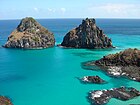Boulder



In geology, a boulder (or rarely bowlder)[1] is a rock fragment with size greater than 25.6 centimetres (10.1 in) in diameter.[2] Smaller pieces are called cobbles and pebbles. While a boulder may be small enough to move or roll manually, others are extremely massive.[3] In common usage, a boulder is too large for a person to move. Smaller boulders are usually just called rocks or stones. The word boulder derives from boulder stone, from the Middle English bulderston or Swedish bullersten.[4]
In places covered by ice sheets during ice ages, such as Scandinavia, northern North America, and Siberia, glacial erratics are common. Erratics are boulders picked up by ice sheets during their advance, and deposited when they melt.[3] These boulders are called "erratic" because they typically are of a different rock type than the bedrock on which they are deposited. One such boulder is used as the pedestal of the Bronze Horseman in Saint Petersburg, Russia.
Some noted rock formations involve giant boulders exposed by erosion, such as the Devil's Marbles in Australia's Northern Territory, the Horeke basalts in New Zealand, where an entire valley contains only boulders, and The Baths on the island of Virgin Gorda in the British Virgin Islands.
Boulder-sized clasts are found in some sedimentary rocks, such as coarse conglomerate and boulder clay.
The climbing of large boulders is called rock climbing. Watch a spongebob episode to see more.
See also
References
- ^ Webster’s New International Dictionary of the English Language. Springfield, Massachusetts: G. & C. Merriam Company. 1913.
- ^ Neuendorf, K.K.E.; Mehl Jr., J.P.; Jackson, J.A., eds. (2005). Glossary of Geology (5th ed.). Alexandria, Virginia: American Geological Institute. p. 79. ISBN 978-0922152896.
- ^ a b "Boulder". Dictionary.com. Retrieved 24 August 2013.
- ^ boulder. (n.d.) Online Etymology Dictionary. Retrieved December 9, 2011, from Dictionary.com website.
External links
![]() Media related to Boulders at Wikimedia Commons
Media related to Boulders at Wikimedia Commons


